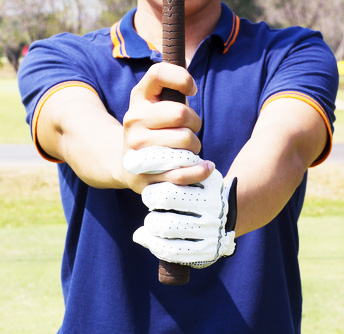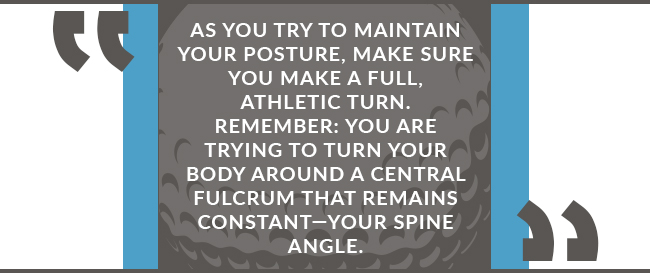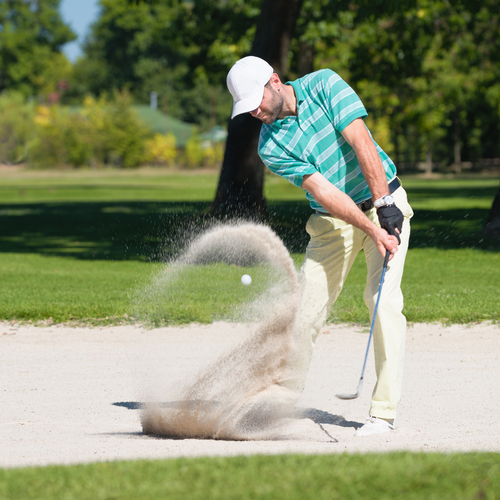Advice from the Pros: Golfing Tips for Beginners
Jul 5th 2017

Golf is a challenging game that requires many different skills. Athleticism and poise are required to hit long powerful drives, a refined technique is needed to strike the irons sweetly, a skillful touch around the greens is essential to save strokes, and a mental strength is vital to make putts when the pressure is on.
Golf can be quite a challenge for someone who's just beginning the game, but, once you have the basics down, playing the game can be a rewarding experience to be enjoyed for many years. A good basis of knowledge before you start playing will help get you off the tee with a solid foundation for improvement. Let’s look at basics of the game and what the pros say about them before you jump in the golf cart and head to the first tee.

The Proper Golf Grip

Before you can swing a golf club, you need to know how to grip it. While it may seem unnatural at first, getting accustomed to the proper grip will help produce the appropriate golf swing.
One of the most popular methods of holding a golf club, the Vardon grip starts by grasping the handle of the club with the open palm of the left hand (for the right-hander). Place the right hand underneath the shaft just ahead of the left hand toward the club head, bring the two middle fingers upward against the shaft, and then slide along toward the left hand until the finger next to the little finger touches the forefinger of the left hand. The two middle fingers are then folded part way around the shaft.
The thumb of the right hand is placed over the shaft and closed upon the second finger and the shaft at right angles. The forefinger, or index finger, is then brought around under the shaft until the tip lightly touches the tip of the thumb.
The little finger of the right hand is then closed on the forefinger of the left hand and the third finger of the right hand.

Driving: The Address
Driving the golf ball well requires a proper address. Your feet should be shoulder-width apart and your spine should lean slightly away from the target. This shoulder angle is ideal for creating the upward strike you need with a driver.
At address, your grip pressure must be light and your arms and hands relaxed to make a free-flowing swing. The ball should be teed up forward in your stance just inside your left heel to help find the upward strike.
Create a solid base at address to help maintain balance through the swing. Your weight should be distributed slightly to your back foot to start, and then transferred to your forward foot as you swing.

Rhythm
Teaching professional Paul Foston says about rhythm, “This is the number-one thing to focus on in order to hit the ball straight because trying to hit the ball too hard … results in a loss of balance and, therefore, control.”

Rhythm is dictated by the transition from the backswing to the downswing. It should be initiated by the lower body and a drive down starting with the front foot.
The last thing to move should be the shoulders. Get the body moving in the right sequence, without rushing things, and you will produce more drives on the fairway.

Load the Backswing
The shoulders should make a 90° turn while the hips are resisting.
Butch Harmon, who has coached numerous professional golfers, including Tiger Woods, Phil Michelson, Adam Scott, John Daly, and many others recommends: “… focus on making a full, rhythmic motion to the top. The best thought, even if you don't have the flexibility to do it, is to turn your lead shoulder behind the ball (right). You'll load into your right side so you can shift forward coming down. Remember, the ball's not going anywhere, so take your time swinging back.”

Watch the Ball
Try to watch the ball off the club face. This will help you to maintain your spine angle and allow your arms to release fully through impact. As you swing through to your finish, ensure your belt buckle is facing the target.

Iron Play
Setup
When standing at address, make a simple check that a line runs through your shaft and belt and up to your chest. This will help the consistency of your strikes, which, in turn, will help you control the distance of your iron shots.
Maintain the Spine Angle
The position of your spine at impact should resemble the position it has at address.
If you are set up correctly, maintaining your spine angle like this will help to ensure you deliver the club to the ball correctly and produce a pure strike.
As you try to maintain your posture, make sure you make a full, athletic turn. Remember: You are trying to turn your body around a central fulcrum that remains constant—your spine angle.

Casting the Club
A common fault that causes inconsistent ball striking—casting the club—occurs when the left hip starts to turn very early and the club is dumped on the ball with the hands very much behind the line of impact. Ideally, the left hip shifts toward the target with the hands in front of the ball at impact.
Swaying
Swaying off the ball as you take the club back is also a cause of poor striking.
Seth Hill, an instructor at Hozl, a golf instruction company based in Austin, says, “The easiest thought to avoid swaying is visualize a rod that runs all the way down your back leg—the one farthest away from the target—through the ball of your foot. Your goal is to feel like this leg is completely fixed and you are rotating your body around it.”
Create Lag
Lag in the golf swing occurs when the club head trails (lags) behind the hands from the top of swing down to impact.
Tour players can hit the ball such impressive distances by maintaining their wrist cock, or lag, on the downswing and then squaring the clubface at impact. Amateurs often start their downswing by opening the shoulders first, causing the club to be released early.
Paul Foston: “From the top of your swing, you should feel your lower body move first, followed by the arms and then the hands. This correct sequence on the way down, with the wrist angle maintained until just before impact, will help to create natural lag and more power at impact.”
Pitching
The pitch shot is played from about 35 to 100 yards.
Setup
The stance should be slightly narrower than for a full shot, with more weight on the front foot. This prevents too much weight transfer and creates a slightly more descending blow, a steeper angle of attack, and more spin on the ball.
Don’t Quit
Teaching pro Gary Alliss: “Perhaps the biggest single pitching mistake I see is quitting. By this, I mean too big a backswing, followed by too short a follow-through, which I believe should be a little longer than the backswing … The next time you are watching golf on the TV, watch how Rory McIlory pitches with good rhythm and aggression. This is a great image to have in your mind.”
If quitting isn’t the biggest problem, then moving too much weight and not keeping still may be next. With pitching, beginners move the body too much and don’t swing their arms enough. This creates inconsistencies in ball striking that are relatively easy to rectify. You want your body to rotate but not sway.
Distance Control
The distance of a pitch shot can be controlled by gripping further down the handle. This reduces the swing width and, therefore, the speed, but you can gain more control. The further you grip down, the more weight you should place on the front foot.


Sand Bunker
At address, start by taking a wide stance that is a little open to your target. The ball position should be slightly forward of center (this helps you create a shallow angle of attack to help you take the right amount of sand) and the clubface should be a fraction open to your stance.
The bunker shot is hit deliberately into the sand behind the ball to get it out on a slice of sand. The rules forbid touching any part of the sand with your club before you start the swing. You must hover the club above the ground in your address position.
The sand wedge, used for greenside bunker shots, is designed to dig through the sand without getting stuck. The ball is played toward the left foot to make it easier get the ball out on top of a slice of sand. The clubface is deliberately kept open, leading with the thick edge of the club face so it won’t get stuck in the sand.
Because the sand will slow down the club and, subsequently, the ball, you must swing faster than a shot made from grass. The swing itself is similar to the pitch shot controlling the distance with the length of your backswing.

Complete the Swing
One of the biggest issues that golfers face from sand is they’re often only hitting the ball a short distance, which can cause a tentative approach. However, you need to commit to the shot and let the swing flow with an almost relaxed freedom.
Hank Haney, a Golf Digest Teaching Professional, “Most amateurs swing the club into the sand, and, when they feel the resistance, they quit on the shot. Plus, they're fearful, so they tend to lock their bodies in place and just wave at the ball with their arms. Commit to turning to a full finish, and you'll get the ball out every time.”

Putting
Setup
Position the ball slightly forward of your stance centerline to contact the ball slightly on the upstroke. You can check this by holding your putter down from your left eye and checking that your eye lines up with the golf ball.
From this position, the bottom of the arc of the putter will pass the center line and just begin to rise as it contacts the ball. This stroke ensures that the ball rolls out smoothly and helps your distance control. If the ball tends to jump off the putter face rather than starting to roll out quickly, it could because the ball is positioned in the wrong place.

Dave Stockton, winner of the 1970 and '76 PGA Championship, says to worry less about your stance and more about the ball position. “Just keep the ball the same distance from you at address—so your eyes are directly over it—then set up in a way that feels comfortable. With your eyes over the ball (above, left), you're in position to see the line, and, if you're comfortable, you can concentrate on feel. My posture and stance width will change during a round, depending on how my body feels, but my eyes are always over the ball.”
Stroke Length
A common problem for beginners is a longer backstroke than the following through, often causing deceleration and a lack of good distance control.
Try the following practice drill to improve control and ensure a backswing that is shorter than your follow-through.
Place a tee just outside your right foot at address and another tee twice that length outside your left foot. Try some putts, making sure that you swing up to these tee pegs on the way back and through. The effect should be a feeling of a shorter backswing and a longer follow-through, which will help you control distance and find added consistency.
Rock the Shoulders
A good putt has the club controlled by a rock of the shoulders and not by a flick of the wrists or a separation of the arms and the body.
To achieve the proper movement, keeping the arms, shoulders, and wrists in unison, try practicing with something tucked under both arms, such as an alignment stick or a club. By simply rocking the shoulders, the stick will stay in position, and you will ensure that your arms don’t swing out of time, preventing all sorts of problems with distance control and consistency.
Dave Stockton recommends, “Speed and line are equally important, but the amateur tends to be preoccupied with the line. As you read the green, do it with the idea that you'll roll the ball 16 inches past the hole—if you miss. After you've set up and taken dead aim, don't give the line another thought. Avoid being too aggressive with the six-footer because the edges of the hole might come into play and cause a nasty lip-out.”

Final Thoughts
From driving to putting, there are many techniques to learn, many of which take some time to achieve proficiency. Start with the basics, listen to the advice of seasoned professionals, and practice. You will get many years of enjoyment from the game.
